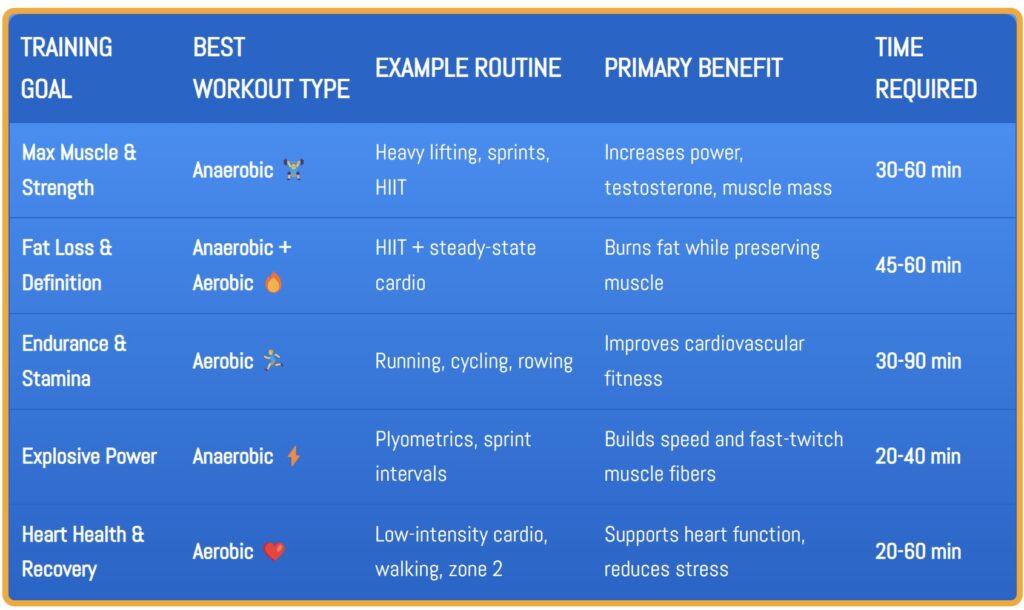You’re mid-squat, barbell digging into your traps, lungs screaming for air. Or maybe you’re pounding pavement at dawn, sweat stinging your eyes, legs churning like pistons. Both moments are battles—against gravity, against fatigue, against the self. But here’s the rub: your body isn’t fighting the same war in each scenario.
Anaerobic and aerobic exercise—two sides of the metabolic coin, two languages of human movement. One is a wildfire, explosive and fleeting. The other, a slow-burning hearth. To master both is to wield precision and power in equal measure. Let’s cut through the noise.
The Metabolic Chessboard: How Your Body Plays the Game
Picture this: You’re sprinting to catch a bus. Muscles ignite. Breath turns jagged. That’s anaerobic—without oxygen—in action. Your body’s tapping into ATP stores and glycogen, fast-twitch muscles firing like flint against steel. It’s raw, urgent, over in seconds.
Now imagine a 10-mile hike. Steady. Relentless. Aerobic—with oxygen—dominates here. Fat and carbs oxidize, slow-twitch fibers hum, your heart settles into a metronomic rhythm. This is endurance, the long game.
“The body isn’t binary,” says Eugene Thong, CSCS. “It’s a spectrum. But understanding where you are on that spectrum? That’s where progress lives.”
The Science, Stripped Bare
Anaerobic Pathways
- ATP-PCr System: 0–10 seconds (think: powerlift, sprint start)
- Glycolytic System: 10 seconds–2 minutes (400m dash, kettlebell swings)
No oxygen required. Fuel: stored ATP, muscle glycogen.
Aerobic Pathways
- Oxidative System: 2+ minutes (distance running, cycling)
Oxygen-dependent. Fuel: fat, carbs, protein.
| Aspect | Anaerobic | Aerobic |
|---|---|---|
| Duration | Short bursts (≤2 mins) | Prolonged (≥5 mins) |
| Intensity | 85–100% max effort | 50–75% max effort |
| Muscle Fibers | Fast-twitch (Type II) | Slow-twitch (Type I) |
| Byproducts | Lactic acid | CO₂, H₂O |
Why Your Goals Dictate Your Path
The Anaerobic Advantage
- Hypertrophy: Tear fibers, rebuild bigger.
- Power: Force production, speed, explosiveness.
- EPOC: Excess Post-Exercise Oxygen Consumption—burn calories post-workout.
“Anaerobic work is the sculptor,” says Charles Damiano, B.S. Clinical Nutrition. “It chisels. But you need the right fuel—carbs, creatine, timing.”
The Aerobic Edge
- Endurance: Mitochondrial density, capillary networks.
- Fat Oxidation: Tap into adipose reserves.
- Cardiac Output: Strengthen the heart’s stroke volume.
“Aerobic fitness is the foundation,” Thong notes. “But do too much, and you’ll sandblast muscle.”
The Hybrid Athlete’s Playbook
You’re not a lab rat. Life demands both—hoisting kids overhead and hiking mountain trails. Here’s how to marry the two:
- Block Periodization
- 8 weeks anaerobic focus (strength/power)
- 8 weeks aerobic focus (endurance)
- Pro tip: Use heart rate zones to stay honest.
- The 80/20 Rule
- 80% low-intensity aerobic (walks, steady-state)
- 20% high-intensity anaerobic (sprints, heavy lifts)
- Nutrient Timing
- Pre-anaerobic: Fast-acting carbs (banana, rice cakes)
- Post-aerobic: Protein + slow carbs (chicken, sweet potato)
The Emotional Calculus: Why This Matters
Remember your first pull-up? The raw triumph? That’s anaerobic grit—proof of conquest.
The runner’s high after miles? Aerobic flow—proof of persistence.
“These systems aren’t just physiological,” Damiano says. “They’re psychological bookends. One teaches you to push limits; the other, to outlast them.”
Your Move
The question isn’t which, but when.
- Morning: Aerobic fasted? Maybe. But sip BCAAs to spare muscle.
- Evening: Anaerobic after carbs? Prime time for power.
Sample Week:
- Mon/Wed/Fri: Heavy lifts (squat, deadlift, bench)
- Tue/Thu: Steady-state cardio (45 mins zone 2)
- Sat: Sprint intervals (20 mins)
- Sun: Hike/yoga (active recovery)
The Final Rep
Your body’s a mosaic of adaptations. Train one system, and the other fades—but only if you let it. The art lies in the dance between fire and fortitude.
So next time you’re under the bar or on the trail, ask: Am I burning, or am I building?
The answer will write your story.
“The best athletes aren’t specialists. They’re alchemists.” —Eugene Thong, CSCS
“Feed the machine, but respect the mechanic.” —Charles Damiano, B.S. Clinical Nutrition
Action List:
- Audit your current split: Is it skewed too far one way?
- Buy a heart rate monitor. Data beats dogma. (Heads up! This link takes you to Amazon. If you buy through it, I might earn a tiny commission— don’t worry, it doesn’t cost you a cent more. You’ll still snag all the discounts and perks Amazon has going on!)
- Next meal: Pair protein with a carb source—strategically.

The weights are waiting. The road is calling. Which voice wins?
